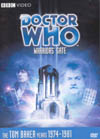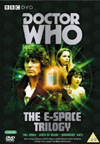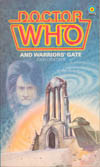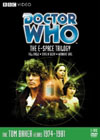DVD Extras include:
The Excellent Concept with the Missing Mechanism
Understanding this ability of the Tharrils is key to understanding Biroc's motivation, and thus most of the advice he spouts throughout the story. He sees how events may unfold near the beginning of the story. He makes a choice and acts on it in episode one. From then on, as far as he is concerned, he need "Do nothing. It is done." The future he has chosen is destined to unfold, by the mere probabilities of the actions of the other characters he has brought together. Or so Gallagher apparently intended. There is a huge flaw in this theory though. If we know anything about the Doctor, it is that he loves to take action and interfere heroically in the affairs of the characters he comes into contact with. Surely that is something that Biroc would see in his visions of possible futures. Yet the Doctor spends almost all of his time in this adventure simply exploring, trying to discover the nature of the bizarre environment he is in and the various cultures he finds there. No real room is left for him to influence key characters and the resolution of the plot, and when he asks Biroc for advice, Biroc spouts his "Do nothing" mantra. That's a formula for an impotent and uninteresting Doctor in a limp story, reminiscent of the problematic historical Doctor Who stories from the 1960's. As Robert Zemeckis reportedly said about similar problems in early drafts of the script for "Castaway", "You're missing an essential story beat." The replacement of that story beat with Biroc's enigmatic "do nothing" statements and other riddles have dragged this story's reputation down with most fans, while some others revere it as being too sophisticated for television. Perhaps just too inarticulate for television in my view. Are the mere presences and odd mutterings from the Doctor, Romana, Adric and K9 enough to justify Biroc bringing them to the scene in the TARDIS? Apart from discovering Gallagher's universe and explaining some of it (but obviously not enough) to the audience, they only seem to antagonize Rorvik a little more than he would have been without them. And he seemed like he would have smashed the mirrors and freed the Tharrils even left just to his own devices and ignorant frustrations. Perhaps Biroc really only wanted Romana, K9, and the Gallifreyan know-how they would bring in the aftermath. Doesn't make an exciting climax to the story though. It is important here too, to note the dominant viewpoint coming through in the dialogue. Rorvik and his crew get most of the lines, and what is perhaps even more important, their lines are the most easily understood, so you can guess how the audience will tend to see the situation. Yes, the Doctor and his kind are too lazy to act. They lack courage and resolve. Had Gallagher's plan for the resolution of his story included some key action for the Doctor to perform, (and a completely non-violent one would be best), it could have both provided what I feel is a more accurate understanding of what allows a choice to lead to an alternate timeline, and made a damn finer tapestry of satisfying story beats. Ultimately I think Gallagher's philosophy itself is lacking this key.
Cinema Divorced from StoryMoving on to investigate the cinematic qualities of this adventure, it is easy to see how further easy points for clarity of story-telling were lost. A very nice atmospheric tour of the empty sections of Rorvik's ship opens the story - but what really is the point? Building up mystery in the minds of the audience as to where the story is taking place? The instant that the techno-babble begins between the crewmembers on the bridge, such mystery is sorely out of place. What was needed was an establishing shot of the ship, showing what kind of bizarre environment it was in, to help the audience make sense both of what was going on, and of what later gets said. Even worse, no establishing shot of the ship appears anywhere in the first episode. We have to wait until Romana lays eyes on it in episode two - nice, but far too late to be visually literate.And what environment is the ship in? According to the novelization, a space battle only just puts the ship into the white void before the events on screen begin, but on TV, we get a line about being "stuck in this nothing for months and months, and now this..." Which is it? Does it matter? The TARDIS too could do with an establishing shot - one of the real police box so that the rotating wire-mesh representations on the Privateer's computer screens might make sense to someone who'd never seen the show before. As it stands, simply cutting between sets of the two ships' bridges for a whole episode, with occasional shots of lone wanderers in a white void, leaves a heck of a lot to be desired. Shots of Biroc moving from ship to void, and void to police box would have been helpful, and a shot of the Doctor exiting the police box also feels vitally important. The satisfying materialization of the police box is also nowhere on the menu today. In the end this just isn't a good story to introduce people to the world of Doctor Who, and at minimum should only be seen after viewing the two preceding instalments of the E-space Trilogy. The story also boasts frenetic, overly confusing editing, as particularly evidenced by anyone who starts watching episode three cold. This portion of the story is full of so many extremely short scenes of various characters in various places doing not-so-obvious things, it would no doubt completely boggle the mind of any casual viewer. The Doctor speaks a line to K9 in the reprise, yet the two don't even appear in shot in the same scene together. At the same time, the audience is being asked to remember that the shots of Romana and the wandering point-of-view, while also completely separate from each other, but liberally intercut with K9's location, are in a completely different location of their own. Throw into that a few odd shots of Adric by himself doing nothing in a white void. This all desperately needs to stay attached to the rest of the story to make sense, as in a movie compilation. Episodically, it's a disaster. Things become a little clearer, spatially, as episode three progresses, but just count the number of half-scenes and half-conversations that the story cuts between during this section, most of which make no real point or have any emotional impact. If the director could stick with something, anything, and follow it through and make it worthy of a longer attention span, the tale would be much, much better off. To top it all off, note that in the midst of this bizarrely edited section, we get the definitive establishing shot of the entire story, panning across the void to show Rorvik's ship, the Gateway, and the TARDIS, backed by the story's definitive musical phrase no less. Great! But why here in episode three? Why right here when, at this point, no characters are drawing any attention to the distances between the three locations? It boggles the mind.
Redeeming Elements
I like the Gundan robots - I think they add much to the mysterious menacing atmosphere, both by their twisted vocalization of essential backstory, and with most of their shorter action scenes. Sadly, episode two's early Gundan action could have been so much more polished with a few additional takes; I sense the relentless studio clock taking its toll on a Doctor Who production yet again. Clifford Rose turns in a top-notch performance as the hard-hitting, tightly coiled Captain Rorvik. Cleverly, the captain's rigidity is elevated by contrast with the enjoyable level of joking around evident in most of the rest of his crew, which the captain never partakes in or approves of, and on occasion argues against. Nice touch. Sadly, Rorvik's final moment on screen is an acting letdown, but thankfully the only one in Rose's performance. It's too bad the director didn't cut away earlier, and add some echo, processing and slowing down of Rorvik's final line and laughter. That would have been a better moment for some of the wandering shots of the empty ship. Adric really is a background character in this story, and seems to have been pasted in at the last minute, although thankfully he is still given a few important things to do. K9 gets plenty of screen time, but for the most part, he is not having a good day at all. He does lend some vital support to the believability of some of the story's more bizarre elements, spouting Newton's Third Law of Physics just when the audience would be ready to call the production phoney for not showing a breaking mirror, etc., but such lovely tidbits can easily get lost amidst all the other nonsense that his malfunctioning circuits are causing him to spew. Personally, I think that letting K9 go mad that way was one of the most disturbing things I ever witnessed on Doctor Who. What a pity K9 didn't get a more noble exit from the program, not managing to fire a single shot in his last story, though at one point he desperately wanted to. Disappointingly, only one laser beam appears in the entire story, and isn't quite lined up properly against the mirror, despite what K9 says. Tom Baker and Lalla Ward give decent performances, making the most of a script that doesn't really gel. In the end, probably not their most memorable performances, providing Lalla Ward's Romana with a somewhat lukewarm finale. The story improves emotionally as she and K9 make their exits though, ending on a generally satisfying note.
International Titles:Deutsch: "Flucht aus dem E-Space"Magyar: "A harcosok gátja"Français: (La Porte des Guerriers)Русский: "Врата воинов"This story is available on DVD and VHS video as the third and final adventure of the E-Space Trilogy. Click on the Amazon symbol for the location nearest you for pricing and availability:
Comments on this article are welcome. You may contact the author from this page:
|











